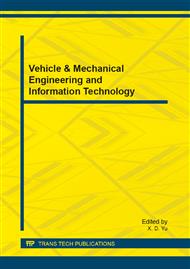p.3
p.9
p.13
p.17
p.25
p.29
p.33
p.42
Research on Temperature Detection Based on Spectrum Analysis of the Speckle Pattern Interferometry
Abstract:
To improve the accuracy of the transient temperature detection system, Transient temperature inversion processing algorithms is proposed based on spectrum analysis of speckle pattern interferometry. The interference fringes is formed by speckle interferometry in the system, and due to transient temperature changes cause the material strain, so that the speckle interference pattern changes. the interference fringes on the measured surface is obtained by the area array CCD collection before and after deformation. The corresponding spectrum density function will changes by the changes of transient temperature, and the amplitude changes of center wavelength is inverted by the speckle pattern interferometry. Through detecting and calculating the ratio of the amplitude of the center wavelength, the transient temperature can be obtained by spectrum analysis. In the analysis and calculation for the function of transient temperature and material strain, material strain and interference fringes, derived the amplitude and phase function of the transient temperature change and interference fringes, so as to provide the necessary conditions for detecting the use of spectral density function temperature. Experiment using 660nm laser diode, SI6600 type area CCD detector to obtain the speckle pattern interference fringes, system extracts the amplitude ratio of the central wavelength from spectral distribution function, and by calculation and calibration the detection accuracy of temperature can be achieved of 2°C. Compared to traditional methods that is direct detection for interference fringes changes, the new methods improve the accuracy by nearly an order of magnitude. It is more accurate detection and better uniformity, better stability.
Info:
Periodical:
Pages:
3-8
Citation:
Online since:
December 2012
Authors:
Price:
Сopyright:
© 2013 Trans Tech Publications Ltd. All Rights Reserved
Share:
Citation:


